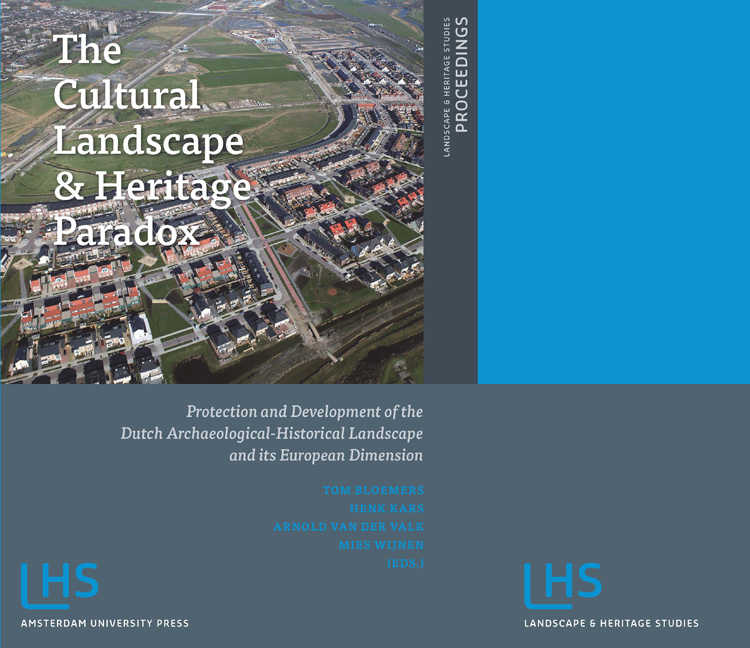 The Cultural Landscape and Heritage Paradox
The Cultural Landscape and Heritage Paradox Book contents
- Frontmatter
- Contents
- Preface
- I INTRODUCTION
- II INSIGHTS AND PROSPECTS OF ARCHAEOLOGICAL-HISTORICAL LANDSCAPE STUDIES
- III LINKING KNOWLEDGE AND ACTION
- IV IMAGINATION - FACTS AND CONSTRUCTIONS
- V SHARING KNOWLEDGE - STORIES, MAPS AND DESIGN
- VI SYNTHESIS AND CONCLUSIONS
- VII MANAGEMENT OF KNOWLEDGE
- VIII AGENDA FOR THE FUTURE
- IX SUMMARY
- X APPENDIX
- Subject Index
- Index of Places and Regions
2 - Planning the Past. Lessons to be Learned from ‘Protecting and Developing the Dutch Archaeological-Historical Landscape’ (PDL/BBO)
Published online by Cambridge University Press: 21 January 2021
- Frontmatter
- Contents
- Preface
- I INTRODUCTION
- II INSIGHTS AND PROSPECTS OF ARCHAEOLOGICAL-HISTORICAL LANDSCAPE STUDIES
- III LINKING KNOWLEDGE AND ACTION
- IV IMAGINATION - FACTS AND CONSTRUCTIONS
- V SHARING KNOWLEDGE - STORIES, MAPS AND DESIGN
- VI SYNTHESIS AND CONCLUSIONS
- VII MANAGEMENT OF KNOWLEDGE
- VIII AGENDA FOR THE FUTURE
- IX SUMMARY
- X APPENDIX
- Subject Index
- Index of Places and Regions
Summary
ABSTRACT
The results of the Dutch PDL/BBO programme are introduced and summarized for an international audience. The programme is a corollary of growing public and professional interest in cultural landscape and heritage since the 1990s. This research programme is to be perceived as the scientific counterpart of the Belvedere central government policy programme. Both programmes start from the same philosophy exemplified in the slogan ‘conservation through development’. Landscape heritage in the Netherlands is under threat due to urbanization, industrialization, expansion of traffic networks and environmental degradation.
Traditional practices of government-led land-use planning no longer provide a remedy against the potentially destructive forces of the contemporary fluid and extreme mobile network society. Now attention is directed towards developments which open up opportunities for heritage conservation. These trends have been identified in field research. They encompass such diverse activities as projects for regional agricultural reconstruction, cultural heritage tourism and urban development. This change is in line with a shift from development control in planning towards collaborative developmental planning. A developmental style of planning and heritage management poses challenges to the domain of applied sciences. Positivistic evidence-based planning is complemented and gradually replaced by interpretative transdisciplinary research. Major lessons learned in the PDL/BBO programme pertain to opportunities and constraints for integrative research and border traffic between the worlds of science, government and governance.
KEY WORDS
Interdisciplinarity; landscape, heritage, preservation, development; land-use planning
INTRODUCTION
The Netherlands covers 41,526 km2; 14% of the surface of the country is taken up by housing, business and infrastructure, some 70% is used as agricultural land. With a population density of 500 inhabitants per km2, it is one of the most densely populated and urbanized countries in the world (Netherlands Environmental Assessment Agency, 2008). In an economic sense, the Netherlands has been in the top 20 of the most prosperous countries of the world for decades (Van der Horst 2007; Needham 2007). The Netherlands, though small, is the world's largest exporter of agricultural products. The combination of population density and prosperity has led to extreme pressure on the use of the environment. Comparing the appearance of cities, villages and farm lands from old postcards and topographical maps from the early 1900s with the modern appearance of the Dutch cultural landscape immediately demonstrates the enormous changes that have taken place.
- Type
- Chapter
- Information
- The Cultural Landscape and Heritage ParadoxProtection and Development of the Dutch Archaeological-Historical Landscape and its European Dimension, pp. 21 - 52Publisher: Amsterdam University PressPrint publication year: 2010
- 1
- Cited by


